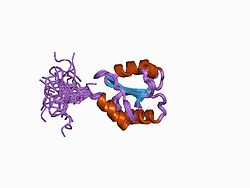Protein folding
PDI displays oxidoreductase and isomerase properties, both of which depend on the type of substrate that binds to protein disulfide-isomerase and changes in protein disulfide-isomerase's redox state. [4] These types of activities allow for oxidative folding of proteins. Oxidative folding involves the oxidation of reduced cysteine residues of nascent proteins; upon oxidation of these cysteine residues, disulfide bridges are formed, which stabilizes proteins and allows for native structures (namely tertiary and quaternary structures). [4] In line with this, zinc ions bind PDIA1 in a redox-dependent manner—both reduced and oxidized forms bind Zn²⁺, but with distinct stoichiometries—leading to pronounced effects on conformational stability (including shifts in thermal denaturation transitions) and inhibiting the thiol-reductase activity of the reduced enzyme. [9]
Regular oxidative folding mechanism and pathway
PDI is specifically responsible for folding proteins in the ER. [6] In an unfolded protein, a cysteine residue forms a mixed disulfide with a cysteine residue in an active site (CGHC motif) of protein disulfide-isomerase. A second cysteine residue then forms a stable disulfide bridge within the substrate, leaving protein disulfide-isomerase's two active-site cysteine residues in a reduced state. [4]

Afterwards, PDI can be regenerated to its oxidized form in the endoplasmic reticulum by transferring electrons to reoxidizing proteins such ER oxidoreductin 1 (Ero 1), VKOR (vitamin K epoxide reductase), glutathione peroxidase (Gpx7/8), and PrxIV (peroxiredoxin IV). [4] [10] [11] [6] Ero1 is thought to be the main reoxidizing protein of PDI, and the pathway of reoxidation of PDI for Ero1 is more understood than that of other proteins. [11] Ero1 accepts electrons from PDI and donates these electrons to oxygen molecules in the ER, which leads to the formation of hydrogen peroxide. [11]
Misfolded protein mechanism
The reduced (dithiol) form of protein disulfide-isomerase is able to catalyze a reduction of a misformed disulfide bridge of a substrate through either reductase activity or isomerase activity. [12] For the reductase method, a misfolded substrate disulfide bond is converted to a pair of reduced cysteine residues by the transfer of electrons from glutathione and NADPH. Afterwards, normal folding occurs with oxidative disulfide bond formation between the correct pairs of substrate cysteine residues, leading to a properly folded protein. For the isomerase method, intramolecular rearrangement of substrate functional groups is catalyzed near the N terminus of each active site. [4] Therefore, protein disulfide-isomerase is capable of catalyzing the post-translational modification disulfide exchange.


